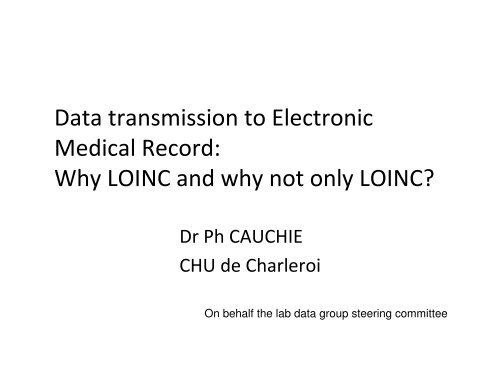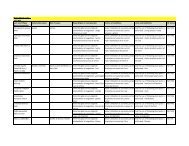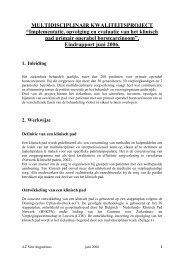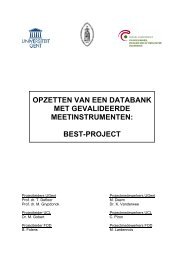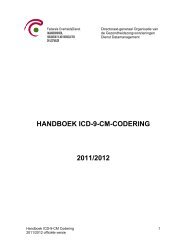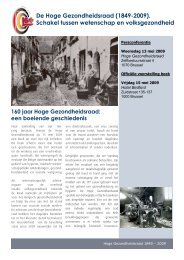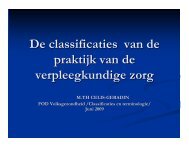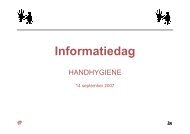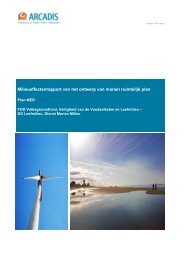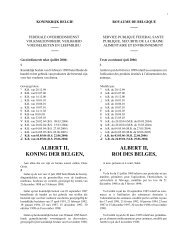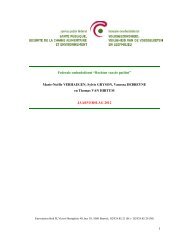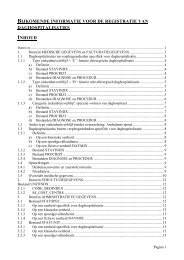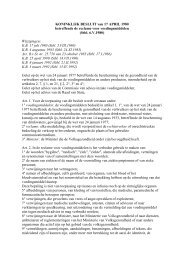Why LOINC and why not only LOINC?
Why LOINC and why not only LOINC?
Why LOINC and why not only LOINC?
Create successful ePaper yourself
Turn your PDF publications into a flip-book with our unique Google optimized e-Paper software.
Data transmission to Electronic<br />
Medical Record:<br />
<strong>Why</strong> <strong>LOINC</strong> <strong>and</strong> <strong>why</strong> <strong>not</strong> <strong>only</strong> <strong>LOINC</strong>?<br />
Dr Ph CAUCHIE<br />
CHU de Charleroi<br />
On behalf the lab data group steering committee
From the lab to the attend physician:<br />
<strong>Why</strong> a code?<br />
LAB<br />
PHYSICIAN<br />
DATA
The belgian experience<br />
• Each EMR has its own internal codification<br />
system. Frequently labs <strong>and</strong> EMR software<br />
providers have to support several lab code<br />
conversions.
Without translation system<br />
LAB1<br />
EMR1<br />
EMR2<br />
LAB2<br />
EMR3<br />
LAB3<br />
EMR4<br />
Each lab has to provide data on multiple coding system
The belgian experience<br />
• Each EMR has its own internal codification system.<br />
Frequently labs <strong>and</strong> EMR software providers have to<br />
support several lab code conversions.<br />
• ACTH: a unique experience:<br />
– The laboratory sends one type of record (the ACTH code)<br />
to a shared translation system<br />
– The translation system provides the code “understood” by<br />
the EMR software<br />
– To date a database of more than 4700 records providing<br />
translation to Gespro, Medigest, Medidoc <strong>and</strong> <strong>LOINC</strong>
With a translation system<br />
LAB1<br />
EMR1<br />
EMR2<br />
LAB2<br />
EMR3<br />
LAB3<br />
EMR4<br />
The translation system provides data following the requested format
The belgian experience<br />
• Each EMR has its own internal codification system. Frequently<br />
labs <strong>and</strong> EMR software providers have to support several lab<br />
code conversions.<br />
• ACTH: a unique experience:<br />
– The laboratory sends one type of record (the ACTH code) to a shared<br />
translation system<br />
– The translation system provides the code “understood” by the EMR<br />
software<br />
– To date a database of more than 4700 records providing translation to<br />
Gespro, Medigest, Medidoc <strong>and</strong> <strong>LOINC</strong><br />
• This system has to evolve<br />
– From a regional to an universally accepted code, but respecting<br />
existing work.<br />
– From a home made database to a secured multi-access system<br />
– Creating an eHealth authenticated source, freely available to all<br />
involved healthcare actors
With a universal reference code<br />
LAB1<br />
EMR1<br />
EMR2<br />
LAB2<br />
EMR3<br />
LAB3<br />
EMR4
Looking for a st<strong>and</strong>ard: <strong>LOINC</strong><br />
• Logical Observation Identifiers Names <strong>and</strong> Codes (<strong>LOINC</strong>) is a database<br />
<strong>and</strong> universal st<strong>and</strong>ard for identifying medical laboratory observations. It<br />
was developed <strong>and</strong> is maintained by the Regenstrief Institute, Inc., a US<br />
non-profit medical research organization, in 1994.<br />
• <strong>LOINC</strong> was created in response to the dem<strong>and</strong> for an electronic database<br />
for clinical care <strong>and</strong> management <strong>and</strong> is publicly available at no cost.<br />
• It is endorsed by the American Clinical Laboratory Association <strong>and</strong> the<br />
College of American Pathologist. Since its inception, the database has<br />
exp<strong>and</strong>ed to include <strong>not</strong> just medical <strong>and</strong> laboratory code names, but<br />
also: nursing diagnosis, nursing interventions, outcomes classification, <strong>and</strong><br />
patient care data set.<br />
• <strong>LOINC</strong> applies universal code names <strong>and</strong> identifiers to medical<br />
terminology related to the Electronic health record.<br />
• Widely accepted:<br />
– Switzerl<strong>and</strong> : CUMUL (French- German- English- Italian- Spanish)<br />
Based on <strong>LOINC</strong> 2.21 (december 2007), 5071 records<br />
– France: CLUABM “version francisée de la nomenclature <strong>LOINC</strong>”<br />
adopted e.g. by APHP. 4408 records<br />
– Translated in Simplified Chinese,….
<strong>LOINC</strong>: everything is beautiful?<br />
• Over 50,000 observation terms (<strong>LOINC</strong> 2.26 = 53344) that<br />
can be accessed <strong>and</strong> understood universally.<br />
• Each database record includes six fields for the unique<br />
specification of each identified single test, observation, or<br />
measurement:<br />
1. Component- what is measured, evaluated, or observed<br />
2. Kind of property- characteristics of what is measured, such as<br />
length, mass, volume, time stamp <strong>and</strong> so on<br />
3. Time aspect- interval of time over which the observation or<br />
measurement was made<br />
4. System- context or specimen type within which the observation was<br />
made<br />
5. Type of scale- the scale of measure. The scale may be quantitative,<br />
ordinal, nominal or narrative<br />
6. Type of method- procedure used to make the measurement or<br />
observation
<strong>LOINC</strong> : side stack<br />
• Powerful but complex:<br />
– Multiple samples, methods, units,….<br />
– Difference between some codes <strong>not</strong> always easy to underst<strong>and</strong><br />
– E.g.: glucose 66 records<br />
• 53344 items but still incomplete<br />
– For hematology 20% of records are lacking<br />
– E.g.: Owren PT (Thrombotest)<br />
• Challenge tests <strong>and</strong> time dependence remain unresolved<br />
• Bacteriology far from complete<br />
– Always a problem for coding systems (antibiograms,….)<br />
• Request codes
The labcodes data system<br />
• Main features:<br />
– A multiple access data base<br />
– Web based<br />
– Several security levels<br />
– search tool in <strong>LOINC</strong><br />
– A “Belgium” primary code is automatically<br />
provided by the system = code « Albert »<br />
– Translation function
Labcodes data system<br />
• Long-term Health-FPS initiative , long awaited<br />
(founding, organisation)<br />
• M<strong>and</strong>atory for eHealth developments (building authentic<br />
sources)<br />
• Current Status:<br />
– Contract with FPS (through FRATEM) for x top drafting tables in 2009 .<br />
– >><strong>LOINC</strong> + Belgian code when relevant<br />
– Limited budget for expert fee<br />
– Develop management application by SMALS (Q1-Q2 09)<br />
– Reporting to eHealth advisory group<br />
– Contact with EMR providers are m<strong>and</strong>atory to prepare the transition<br />
– Steering committee : Philippe Cauchie, Annie Borremans, Tom Fiers, Francoise<br />
Luyckx,
The Belgian labcodes database system
The belgiam system
Conclusions<br />
• The steering comittee has to<br />
– underst<strong>and</strong> how to use <strong>LOINC</strong><br />
– define the rules of use<br />
• Piloting work will be necessary<br />
– Dimension (witch one? )<br />
– Methods (all necessary?)


